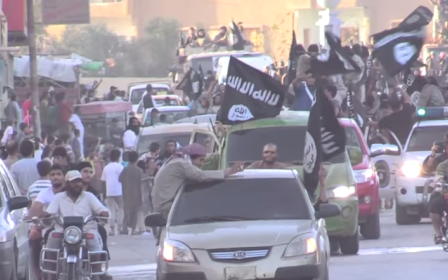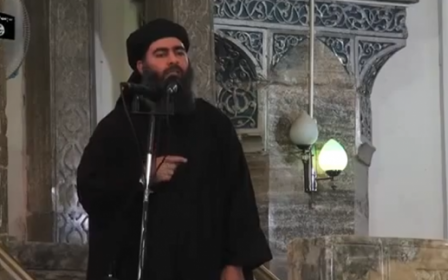US airstrikes could bring militants closer together, analysts and fighters warn

ERBIL – There are growing whispers that the US airstrikes targeting both the al-Qaeda affiliated Nusra Front and the Islamic State in Syria in recent months could bring the former rivals closer together.
This week, a report emerged that leaders of the two groups secretly had gathered in a farmhouse in northern Syria and agreed to work together.
Militant fighters and analysts, however, remain doubtful and believe that cooperation between the rival groups remains unlikely.
Since the US-led coalition launched its battle against IS, the two groups have been on the receiving end of heavy airstrikes. On 23 September, US fighter jets targeted the Khorasan group, which the US suggested was planning to attack the West, striking Nusra bases at the same time.
For the second time, on 6 November, US aircrafts targeted non-IS groups, including Nusra, and the Salafist Ahrar al-Sham rebel group. Leaders of IS and Nusra proclaimed the US airstrikes to be a “war against Islam."
Despite their shared attacks, rebel cooperation between the two groups has remained limited.
‘Moderates’ versus Nusra
Working together or not, many so-called moderate rebels in Syria see both groups as a threat.
“Nusra is an extension of Daesh [IS] in the areas outside its control. If they don’t agree, they are still of the same thought and base and the two pose a danger to the moderate forces,” said Ahmed Hissau, a spokesperson of the Kurdish Front from Aleppo. His group is part of the Free Syrian Army (FSA) and has fought both Nusra and IS in the past.
The Nusra Front defeated the Western-backed rebel groups, Harakat Hazm, and the Syrian Revolutionary Front (SRF) in the beginning of November in Idlib, in cooperation with other militant groups. Some say during these battles, IS-fighters offered to back Nusra.
But Aamer Hassan of the FSA-group, Dawn of Freedom - which fights against the IS in Kobane - denied the presence of IS. "No brother,” Hassan told MEE. “There is no member of Daesh [Arabic acronym for IS] in the Idlib countryside."
Muhajiri Shaam, the nickname of a Dutch Nusra-member based in Syria, also denied the rumours.
“I don’t rule out cooperation in the future, but to post fabrications to show something which is not there is sly,” Shaam said. “There are many lies, like [the lie that] 100 IS fighters that would have jointly fought against SRF [in Idlib]. That’s not true!”
A war against Islam
In a recently released statement, Nusra leader, Sheikh al-Fateh Abu Mohammed Joulani said that the coalition strikes not only aim to destroy Nusra and IS, but also to battle against Islam.
“They will arm and train them to eliminate Jabhat al-Nusra and Jam’ah Dawlah, which is the stated goal. But of course, they will also target all of the Islamic factions as well, or all factions that do not submit to Western policy that will be imposed on the region,” Joulani said.
Most militant groups share Joulani’s view and see the coalition strikes as a war against Islam, said analyst and Middle East expert Pieter van Ostaeyen. There are signs that smaller groups and individual fighters are coordinating their efforts more.
“But if Jabhat al-Nusra and Islamic Front cooperating together on a larger scale would seem unlikely for the time being. The ideological differences between the groups seem to be too big,” he told MEE.
The more both groups are targeted, however, the closer both sides will become, he said.
“Both al-Adnani [IS’s spokesperson] and al-Joulani [Nusra leader] in statements have indicated that this is a war against Islam. Both say that civilians in coalition countries are justifiable targets,” van Ostaeyen said. “Thus, I expect more cooperation on a local level, but if they will ever merge together will remain a question.”
Aymenn Jawad al-Tamimi, who researches militant movements for the Philadelphia-based Middle East Forum, said the Nusra Front was not surprised by the US airstrikes that have targeted their group, though the US originally said they were intended for IS.
“The US airstrikes have lived up to predictions from Nusra members that the coalition would not just target IS, but nothing points to actual cooperation,” Tamimi said, pointing out there is only limited cooperation in Qalamoun mountains, located on the Lebanese border.
Tamimi argued that by consolidating territory in Idlib and reducing its Aleppo footprint, Nusra is actually trying to get into a position where it can deliberately avoid direct fighting with IS as much as possible.
“But the dispute between Nusra and IS is too great to bring about a coordinated campaign of cooperation beyond very localised exceptions such as in Qalamoun,” he added.
In Qalamoun, IS and Nusra fighters jointly confront the Syrian government and Hezbollah, “because their numbers [of IS] are limited there,” Nusra-member Muhajiri Shaam said. “The border of Lebanon makes the situation very dangerous and threatening.”
Ideological problems
Unlike the IS, which announced its own caliphate with Abu Bakr al-Bahgdadi as emir in June 2014, Nusra has denied reports that it would announce its own emirate, and refuses to recognise IS as a state. Moreover, Nusra works with other, more secular groups.
“Dawlah [IS] sees itself as a state and Nusra as a group. Dawlah believes Nusra to be out of the fold of Islam. They say they worked with FSA against them. Dawlah will never work with them,” said a militant fighter who wished to remain anonymous.
Tamimi agrees, at least for now.
“For example, Joulani and others in Nusra still call IS 'jamaat ad-dawla'. That's too much of an insult for IS to handle to bring about a real reconciliation,” he said. The insult is in reference to IS not being an Islamic State, rather just a group / organisation that holds no authority over Nusra.
Reportedly last week, the ceasefire offer of Jaish al-Muhajireen wal-Ansar leader, Salkhuddin Shishani, to the IS in Raqqa was rejected. IS called on Nusra to swear loyalty to the caliphate, and called other militant factions “apostates” and “infidels.”
“Nusra did not announce anywhere that they will cooperate with them. It must be clear that Nusra and IS have too many differences and disputes that should be solved according to independent Islamic court. Sheikh Abu Mohammed Al-Maqdisi [A Salafist Palestinian-Jordanian writer] tried for months to solve the differences to the two sides, but there is nothing new,” said Mahujiri Shaam, a Nusra member.
Ongoing infighting
Other militants point out that too much blood has been shed, and the leaders of Nusra and IS do not want a merger as a result of personal rivalries. IS often accuses the Nusra leader of defecting from IS.
In July 2014, IS killed the Deir Ezzor Nusra chief and took over the city from Nusra and Ahrar al-Sham. “Nusra fought fiercely for months against the IS. Many were killed, and many were executed,” Shaam said.
Furthermore, Nusra accused IS of attacking them after the US airstrikes. “It is indeed true that late September after the first attacks of the US, the IS in the north of Aleppo carried out an attack against Nusra,” Shaam said.
Abdurrahman Saleh, a spokesperson for the Ahrar al-Islam opposition group of fighters, also thinks it is unlikely that the two sides would work together since they are using the same slogans and are competing for the same support base.
“The first principle of the IS group is: ‘whoever is not with us, is against us.’ So they want other people to pledge allegiance to them. So Nusra must be under IS. They say they have a caliphate so everyone should fight under their banner,” he said.
Khorasan myth
Both Nusra and the Islamic Front think the Khorasan group, an obscure branch of al-Qaeda that was alleged plotting attacks on the West and which attracted US airstrikes in late September, is an invention created by the US government. FSA rebels are worried that the Syrian government will benefit from any US airstrikes on Nusra, and the increasing disunity among rebel factions.
“As for the Khosasan, there is no such group in Syria; it is a cover for the US to target anyone other than IS. Nusra is mostly composed of Syrians. They will not think of targeting the US while Assad forces are everywhere in Syria,” said Saleh.
He also pointed out angrily that the rebel groups don’t share the US perspective on terrorism, amidst worries that the US could possibly work with the Syrian government in the future to defeat the militant movements.
“We consider the Assad regime as the source of terrorism. So as long a group of people are fighting against the regime, they are acceptable,” Saleh said. “For the West, you can kill millions without being considered a terrorist, as long they are not against the superpowers.
“The Assad regime is an example. Even IS would be accepted by the world if it had not declared its hostility against the US,” he added.
Unity
Still many Islamist fighters told MEE that they have hopes that the groups will unite in the future to fight against the West and other secular groups.
“If all the powers of the mujahedeen [people who wage jihad] worldwide would be united, this would have significant benefits for the jihad, the mujahedeen and with this also the Muslims,” said the Nusra member, Muhajiri Shaam.
But unity will remain difficult if IS expects other militant groups to pledge allegiance. In his latest statement, IS’s leader, Abu Bakr al-Baghdadi, provoked other militant groups by suggesting that if they had not pledged allegiance to IS, they were non-existent, according to the Long War Journal.
“IS has divided the unity of the global jihad movement in two,” Shaam added, referring to attempts of the IS to get more pledges of allegiance of fighters in other Muslim countries.
Middle East Eye propose une couverture et une analyse indépendantes et incomparables du Moyen-Orient, de l’Afrique du Nord et d’autres régions du monde. Pour en savoir plus sur la reprise de ce contenu et les frais qui s’appliquent, veuillez remplir ce formulaire [en anglais]. Pour en savoir plus sur MEE, cliquez ici [en anglais].




